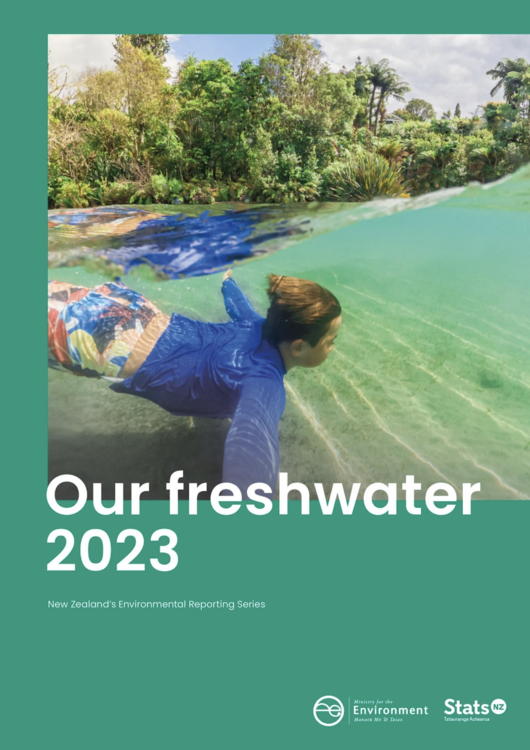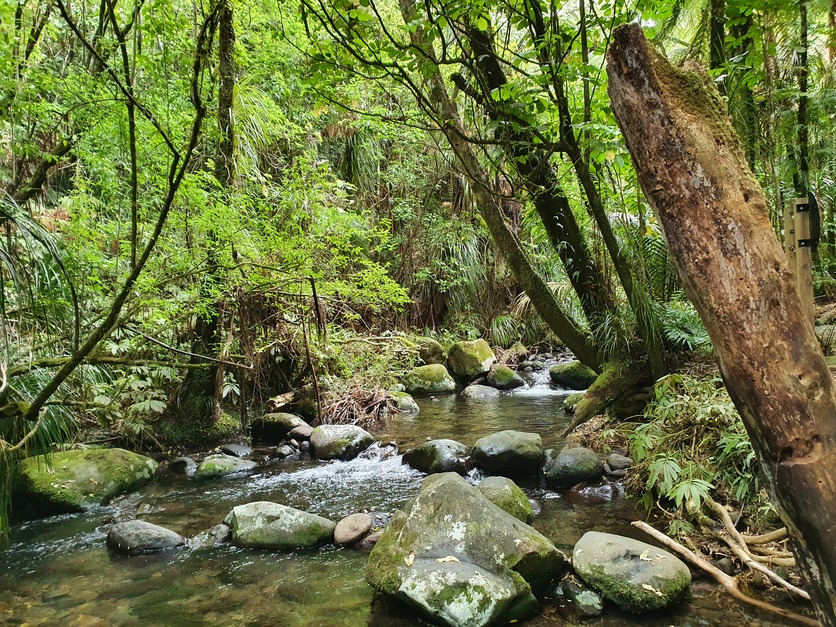Ki uta ki tai – from the mountains to the sea – acknowledges the journey that water makes from the atmosphere to the mountains and across the land. Humans interact significantly with this journey.
Aotearoa New Zealand’s freshwater environment supports all aspects of our lives, and we share an intimate and innate connection with it. It is central to our wellbeing, supporting our economy, recreation and gathering food. For many Māori, the freshwater environment is central to tikanga Māori, mātauranga Māori and mahinga kai.
Despite this, our freshwater environment is under pressure from our activities on the land and in the water, and from a changing climate. While some of our freshwater bodies are in a reasonably healthy state, many have been degraded by the effects of excess nutrients, pathogens, and other contaminants from land.
Our freshwater 2023
Aotearoa New Zealand’s Ministry for the Environment and Stats NZ report on the state of different aspects of the environment (for example, atmosphere and climate) and the environment as a whole. This reporting helps us understand our environment, track impacts of human activities over time and identify challenges. Our freshwater 2023 uses the framework of pressure, state and impact to report on freshwater in Aotearoa. The logic of the framework is that pressures cause changes to the state of the environment and these changes may have impacts.
Freshwater connections and whakapapa
The freshwater environment is a holistic system that connects landscapes, ecosystems and people. Observing a topographic map reveals the many connections between streams, rivers, lakes and wetlands. Each freshwater system sits within a catchment area, which influences the biodiversity and ecology of the system. Humans are also part of this system – via our use of the water and the land around it or through whakapapa (kinship relationships).
The kinship relationship between Māori and the natural world views all people as part of the natural system – the human and non-human worlds are indivisible. There are many pūrākau relating to the origins of freshwater systems – each with its own whakapapa to describe their relationships to their important waterways.
In te ao Māori, different water bodies have associated taonga species and kaitiaki that protect the mauri of the wai. Mauri is a concept that describes the spark of life and the active component of that life. It is the binding force that holds together the physical and spiritual components of a being or thing. There is an intrinsic link between the health and wellbeing of water and the health and wellbeing of communities. When mauri is negatively affected, this can affect the cultural, spiritual and physical wellbeing of communities.
Mauri is often used by scientists to describe the state and sustainability of a particular environment and demonstrates how mātauranga Māori and science can work together to inform local environmental health.
Pressures on freshwater
Freshwater environments are affected by pressures from human activities. Land use, including agriculture, horticulture and forestry, and urban expansion continue to add nutrients, sediment and other contaminants to our freshwater. About half of all urban wastewater is discharged to rivers and lakes. Of concern are contaminants such as microplastics, pharmaceuticals, personal care products and industrial compounds. Urban stormwater carries contaminants such as oils and metals to waterways. Plastic wastes continue to be a widespread problem, with microplastics from smaller urban streams making their way to larger water systems.
It’s not just what we put in our freshwater – we are also removing water for irrigation. Irrigated land area has almost doubled since 2002. This allows greater agricultural production, but it can also change river flows, increase nutrient leaching and alter the habitats of native species. Irrigation can also increase pressure on mahinga kai, recreation and drinking water supplies. Hydroelectric generation usually doesn't remove water from freshwater systems but it does affect the timing and flow of water, which in turn has downstream effects on habitats.
Greenhouse gases – what we put in the atmosphere – also increase pressure. Climate change will affect the amount of water in our soils and the storage and flows of water in lakes, rivers, groundwater and glaciers. A changing climate also alters patterns of rainfall (and droughts), which will affect ecosystems, primary production, energy and recreation.
State of our freshwater environment
Our freshwater 2023 notes that the health of our freshwater ecosystems is variable around Aotearoa. Estimates based on monitoring data show that around half of our rivers and lakes have moderate or severe issues due to pollution or nutrient enrichment. This causes harm to ecosystems and our ability to use rivers and lakes for activities like swimming. Monitoring shows that many of our aquifers are also affected by pollution, and this harms our ability to safely use them for drinking water. Some of our indigenous taonga freshwater species such as kanakana/piharau and kākahi are threatened with extinction and many others are at risk.
Impacts on people and ecosystems
The state of our freshwater environment has impacts on our culture, recreation, freshwater species, habitats, ecosystems, health and economy. The degradation of our freshwater can impact the ability to maintain, develop and transmit traditional Māori knowledge and tikanga Māori and access mahinga kai. There are health risks associated with contaminated drinking water and toxic algal blooms. Aspects of our economic wellbeing are linked to the environment – infrastructure, effects of flooding and droughts in urban and rural areas. Native ecosystems are also impacted by poor water quality, pest plants and animals, and artificial structures like culverts disrupt species migration. Climate change is likely to shift the ranges of our freshwater species, ecosystems and biodiversity.
The right information helps us take action
The information in Our freshwater 2023 may feel overwhelming. Due to the independence of the environmental reporting regime, Our freshwater 2023 does not cover the work that organisations and communities are doing to mitigate the issues.
However, the report does provide evidence to enable open and honest conversations about the choices we make in managing and responding to the impacts of our activities on freshwater environments.
Nature of science
The Ministry for the Environment and Stats NZ note that environmental data is collected for different reasons and by different people. Collecting, synthesising and reporting environmental data to produce consistent, nationally representative datasets is a significant challenge.
Related content
Navigating our freshwater environment is an interactive storymap that explores the state of our rivers, lakes and wetlands from the perspective of a migrating eel. This activity helps educators deepen student engagement with the storymap.
Aotearoa New Zealand’s Ministry for the Environment and Stats NZ produced Environment Aotearoa 2022 as part of its environmental reporting series. Environment Aotearoa 2022 has a unique approach that uses te kāhui o Matariki as the guiding framework for the report. The report used Waitī to represent our essential connection to freshwater and how we are impacted by the degraded state of many of our freshwater environments. The mauri concept for Waitī links the health of freshwater to everything that is connected to it.
Our land 2024 is part of the Ministry for the Environment and Stats NZ reporting series. The focus is on the impacts of land use.
Visit the Hub’s freshwater topic for a wealth of resources. Use the filters to narrow your search.
See our Pinterest Board featuring our collaborations with the Ministry for the Environment and Stats NZ – wrapping educational resources around the state of environment reports.
Useful links
Stats NZ and the Ministry for the Environment report on different aspects of Aotearoa New Zealand’s environment every 6 months. Access the reports here.
Visit Stats NZ for earlier freshwater reports and many of the indicators used to inform Our freshwater 2023.
Acknowledgement
This resource has been produced with the support of the Ministry for the Environment and Stats NZ. (c) Crown Copyright.




